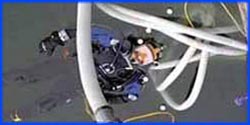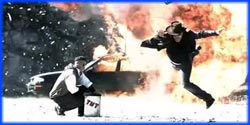


Premier Date: February 22, 2014
confirmed
Adam and Jamie set up a test range and used a sword forge to heat the rifle barrels so they could be bent by hand. A control with an unmodified barrel saw the rifle fire with a muzzle velocity of 1,216 ft/s (371 m/s) and fully penetrate a block of ballistic gel. Subsequent tests with barrels bent to 45, 90, 135 and 180-degree angles all saw the rifle fire successfully, with all the bullets fully penetrating the ballistics gel. They declared the myth confirmed while noting that the bullets began to tumble as soon as a bend was introduced, implying that a rifle with a bent barrel would only be accurate at close range.
busted
The tape measure stopped .22 and 9mm rounds, but was penetrated by a .40-caliber round.
busted
.22 rounds fully penetrated the golf ball.
(This segment was cut from the U.S. broadcast.)
busted
9mm rounds fully penetrated a leather wallet filled normally (a mix of cash and credit cards), a duct-tape wallet filled normally, and a leather wallet overstuffed with cash.
busted
The Build Team set up an analog of a wolf behind bullet-resistant plastic for testing. A first test using a hand-sharpened tree branch failed to set off the shotgun shell. A second test using a shop-made spear of Handroanthus wood (chosen due to it being harder than the brass primer of the shell) also failed despite the primer of the round becoming dented. The third test, working under the assumption that the film’s survivors found a metal screw to use as a firing pin, finally got the shell to go off, but caused no damage to the wolf analog as there was no barrel to contain and direct the pellets. The team declared the myth busted owing to the lack of injury, and pointed out that attacking the wolf with the sharpened stick alone would be just as effective.
busted
Adam and Jamie placed a revolver with a remote-firing mechanism in a vacuum chamber made from bullet-resistant plastic with a steel-plate backing. Two test shots (a control under normal conditions and a test with the chamber fully evacuated) saw the gun fire successfully, with high-speed-camera footage and a measurement of the width of the imprint of the bullets on the back panel of the chamber confirming that normal atmosphere slowed the speed of the bullet by 5%. They also observed that the fireball caused by the gun firing was much larger in the vacuum, owing to the lack of air allowing the gases to expand more and causing Jamie to speculate that outer space explosions would be much more massive than their atmospheric counterparts.
busted
The Build Team carried out testing at the gun range using neon signs specifically constructed for the test by Kari with some expert help. Both 9mm rounds and shotgun shells simply put out the signs when hit, not causing any sparks. Declaring the myth busted at this point, they attempted replicating the results using signs filled with hydrogen instead of neon and using high-voltage arc discharges to light them, but this effort also failed to generate any sparks.
confirmed
At the bomb range, Adam and Jamie set up a container with a heater to bring cooking oil up to temperature and attached a mechanism to lower a 9mm pistol into it. Once the oil reached a typical frying temperature of 390°F (199°C), they turned off the heat and immersed the pistol. The gun eventually discharged after three and a half minutes. Declaring the myth confirmed, they reset the equipment with unheated oil for a second test to see what the minimum temperature to set off the gun was; the weapon fired once the temperature reached 344°F (173°C).